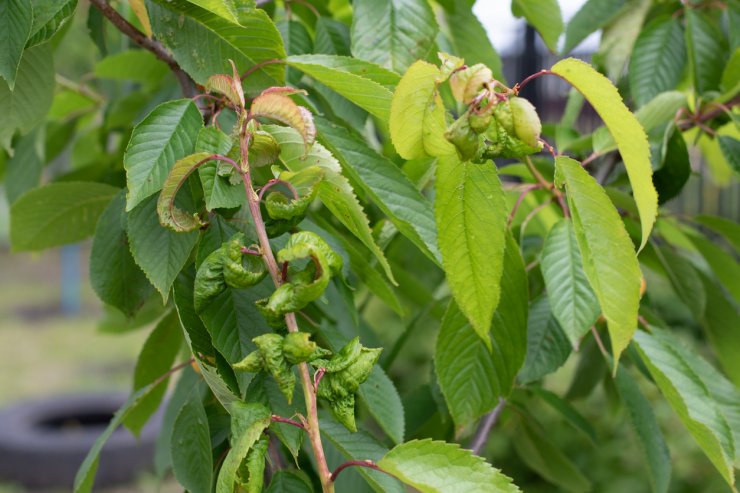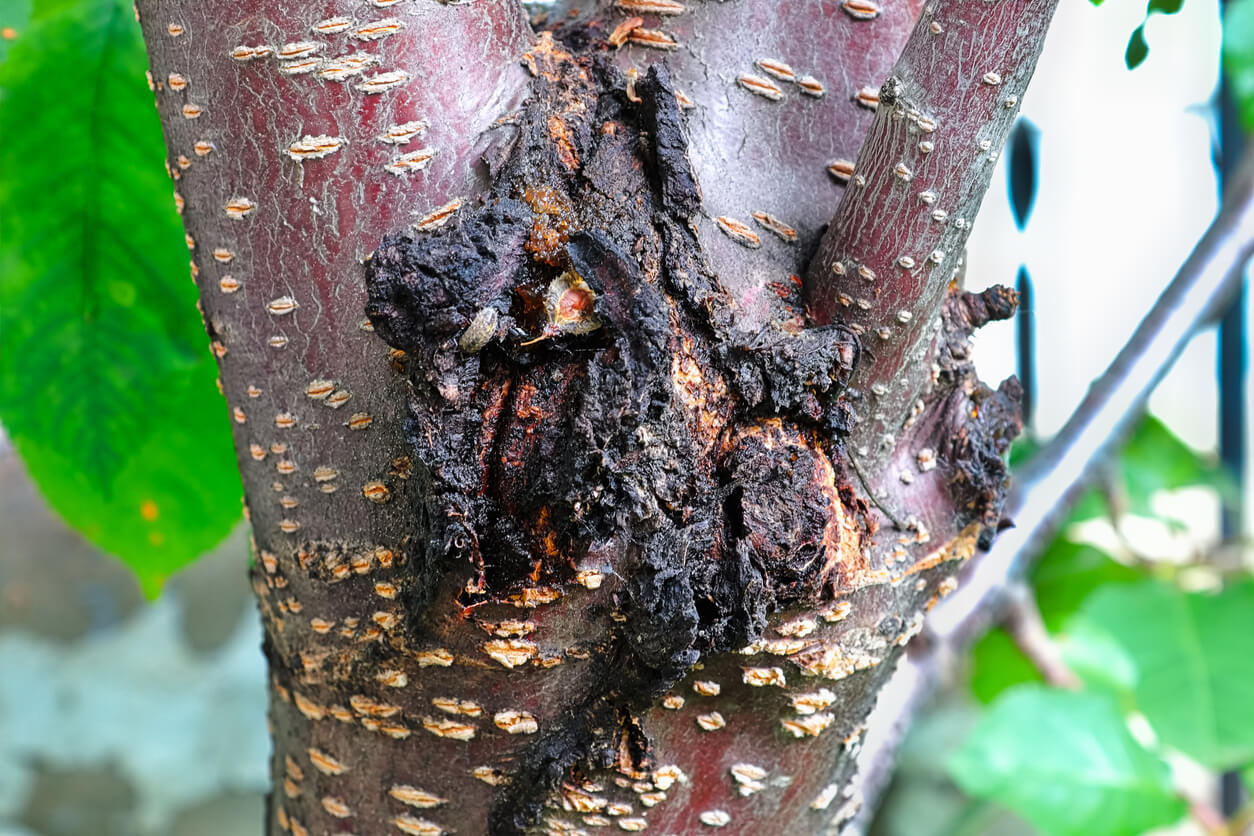
Cherry tree afflicted with fungal infection
As it grows, a cherry tree, like most fruit trees, may experience issues caused by pests or diseases. Things such as location, weather, and upkeep determine which problems your trees will encounter and how well they stand up against them. And your first line of defense is to buy disease-resistant cherry trees.
But routine good practices are also helpful, including adequate watering, fertilizing only as needed, seasonal pruning, preventive and active spraying, fall cleanup, and winter protection.
Cherry tree diseases are caused by bacteria, fungi, and viruses. The diseases can spread through the soil, water, air, infected tools, animals, insects, and even gardeners themselves.
Spot diseases on your cherry trees sooner so you can treat plants before they are destroyed by disease and can successfully manage symptoms. Here is a three-step approach to keeping vigilant about the presence of cherry tree diseases:
- Research the risks. Find out about cherry diseases that are prevalent in your geographic area. When possible, buy disease-resistant cherry tree varieties to avoid diseases in the first place.
- Examine trees daily. Check your cherry trees every day to be sure no disease symptoms are present or emerging.
- Spot diseases early. Catch and treat disease quickly so your plants can recover and thrive. Throw away or burn infected branches instead of composting them to prevent diseases from coming back to your garden via the compost.
We’re believers in not using toxic materials in the garden—they can hurt the plants, hurt the soil, damage the environment, and harm you.
Here are some of the diseases you may spot on your cherry trees.
Armillaria Root Rot (aka Mushroom Rot)
Cause: Fungus (Armillaria)
Symptoms:
- diseased crown and main roots have white/cream-colored mats growing just under bark
- trees are stunted or slow-growing
- leaves may be smaller than normal
- leaves may wilt, brown, and die
How it spreads:
- soil-borne fungus infects roots
- diseased roots infect healthy roots
- wet soil conditions make tree vulnerable
Treatment:
- remove tree to prevent spread of infection
Prevention:
- purchase disease-free trees
- use a preventive dip or spray before planting
Botrytis
Cause: Fungus (Botrytis)
Symptoms:
- leaf, stalk, and crown rot
How it spreads:
- fungus overwinters in infected plant material
- rotting material near plants
- wind, insects, and birds
Treatment:
- removed and destroy infected plant parts
- apply fungicide at first notice
Prevention:
- use liquid copper fungicide
- keep rotting material away from plants
- plant disease-resistant varieties
- remove plant debris
Brown Rot
Cause: Fungus
Symptoms:
- poor growth
- low fruit yield
- cherry blossoms brown and die
- cankers on branches
- small, brown lesions on fruit
- lesions may cover fruit
- infected areas are covered with powdery spores
How it spreads:
- soil-borne fungus
- water
- air
- birds and insects
Treatment:
- prune infected branches during dry weather
- apply natural copper fungicide
- apply fruit tree fungicide
Prevention:
- purchase disease-resistant trees
- prune regularly to keep tree open to light and air circulation
- disinfect pruning shears between cuts
- remove pruning debris to prevent spread of spores
- remove damaged or diseased branches
- thin fruit so cherries don’t touch
Cherry Buckskin Disease (aka X-Disease)
Cause: Bacteria
Symptoms:
- fruit is small, pale, and leathery
- fruit is flat and pointed
- leaves on some branches are mottled
- leaves on some branches turn red and fall off
How it spreads:
- leafhoppers infect tree tissue and spread pathogen
- injury to roots
- infected gardening tools
Treatment:
- remove entire tree to prevent spread of infection
Prevention:
- remove plants that attract leafhoppers, including boxwood, crabapple, hawthorn, lilac, myrtle, privet, and viburnum
- spray host plants to control leafhoppers

A cherry tree with a canker infection
Bacterial Canker (aka Gummosis, Sour Sap)
Cause: Bacteria
Symptoms:
- cankers on or circling branches or trunk, darker than the normal bark, with sunken centers
- gumming occurs in spring and fall, when cankers form
- growth beyond the canker may wilt and die
- angular leaf spots in purple, brown, or black
- leaf and flower buds die in the dormant season because of fall infection; small cankers can develop at the base of dead buds
- infected fruit may blossom normally and then die
How it spreads:
- bacteria overwinters in infected buds and the margins of existing cankers
- rain, cool temperatures, and high winds
- frost-injured leaves and blossom spurs are susceptible to infection
- poor soil drainage
- infected gardening tools
Treatment:
- remove infected parts of tree to prevent spread of infection; prune several inches below canker to protect tree
- prune after summer harvest when weather is hot and dry
Prevention:
- purchase disease-resistant trees
- apply liquid copper fungicide after leaves have fallen in autumn and in spring before the tree buds
- apply 10% lime sulfur beginning at leaf drop in the fall when weather is dry and temperatures range around 70 degrees F
Crown Gall
Cause: Bacteria
Symptoms:
- root and crown distortion; swelling (galling)
- infection can appear on roots, trunk, and branches
- trees are stunted or slow-growing
- tree may stop fruiting
- leaves may be small
How it spreads:
- soil-borne bacteria infects roots
- injury to roots
- infected gardening tools
Treatment:
- remove tree to prevent spread of infection
Prevention:
- purchase disease-free trees
- use a preventive dip or spray before planting
Phytophthora Root and Crown Rot
Cause: Oomycetes (water molds)
Symptoms:
- plants not thriving
- leaves turn yellow, then red, then collapse
- crowns exhibit black-brown decay
- large roots missing feeder roots
- larger roots have brown-black holes
How it spreads:
- rain helps spread spores in temperatures between 65 to 75 degrees F
- overwatering can spur crown rot
Treatment:
- remove and discard infected material
Prevention:
- buy or acquire healthy plant stock
- plant in well-drained soil
- remove and destroy infected plant material as soon as you discover it
- avoid planting in cool, wet weather
- avoid overhead watering; water at soil level
- make sure plants have good air circulation and lots of sun
Powdery Mildew
Cause: Fungus overwinters on infected plant debris and emerges in warm, humid weather
Symptoms:
- white, powdery patches on leaves
- leaves may curl and turn upward
- new shoots appear stunted
- older infections look like a tan or reddish-brown felt covering; these contain spores
- heavy mildew infections can stunt a plant’s growth
How it spreads:
- fungus overwinters in infected plant debris
- spores do not need moisture to germinate; often called a “dry weather disease”
- wind, insects, and birds
Treatment:
- in the spring, prune any shoots that have a white coating (spores)
- removed and destroy infected areas
Prevention:
- apply liquid copper fungicide
- use sulfur-based fungicide, if necessary
- plant disease-resistant varieties
- remove plant debris
Have you had problems with diseases attacking your cherry trees? What types of problems do you regularly face with your trees? Please tell us how you treat and prevent diseases from destroying your cherry crop.


 Previous
Previous

